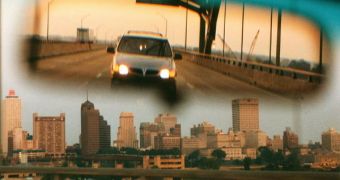Some modern cars have been endowed with Heads-Up Displays (HUD) over recent years, namely systems that project useful information about a car directly on the interior of the front car window. This means that drivers no longer have to take their eyes off the road, in order to get a clue of how fast they are going, how much gas they have left in the tank, and so on. But this technology has thus far only been used in expensive cars. Researchers have now created a holographic HUD, which can be projected on rear mirrors.
Because they have a smaller surface to cover, the HUD systems are a lot less cheaper, while at the same time maintaining their functionality. The compact projection device fits inside an average rear-view mirror. “We can make an HUD so small you can put it into a rear-view mirror or wing mirror,” Edward Buckley says. He is the head of business development at Light Blue Optics, the manufacturer of the new system. The company is based in Cambridge, the United Kingdom.
The prototype system was able to project an image through a two-way wing mirror, creating the illusion that the actual image is some 2.5 meters away. The holographic projection appears to be superimposed on the reflected road scene, and only a narrow perspective hints that the image is actually formed from the mirror, and doesn't simply follow the driver around. Additionally, the new HUD systems do not require massive liquid-crystal arrays and other optical devices.
“In a BMW 5 Series, the size is about five liters. We can make it about one-tenth of the size. This means you can start to put these virtual image displays where you couldn't previously,” Buckley explains. Size is “the number-one detriment in getting HUDs into vehicles,” Ford in-car display expert Mark Larry adds. The new prototype was showcased today at the Society for Information Display's Vehicles and Photons 2009 symposium, Technology Review reports.
“Once someone drives with [an HUD], the universal reply is that they never want another car without one. The safety benefits become obvious in daily use. More features are being added as higher-resolution displays become available,” General Motors HUD specialist lead engineer Steven Stringfellow concludes.

 14 DAY TRIAL //
14 DAY TRIAL //